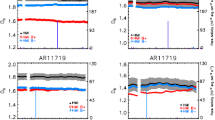Abstract
The magnetograms of 16 active regions, observed during June–November 2015, were obtained from the Joint Science Operations Center (JSOC) from the Solar Dynamics Observatory (SDO) using the Helioseismic and Magnetic Imager (HMI) and used to determine the fractal dimensions of various magnetic field groups. The fields were divided into strong (positive and negative) and weak (positive and negative) groupings. The area-perimeter method was used to determine the fractal dimensions for the umbral and penumbral regions of the magnetograms. The fractal dimensions were found to be \(1.79 \pm 0.49\) and \(1.96 \pm 0.29\) for strong and weak magnetic fields, respectively. When compared to the umbral and penumbral fractal dimensions determined by Rajkumar, Haque and Hrudey (Sol. Phys.292, 170, 2017) using white light images, an inverse relationship was found, with the umbra showing lower fractal dimensions than the penumbra for the magnetic field groups compared to the intensity images. This directly implies that there is greater complexity in the penumbral magnetic field groupings than the umbral region. This has implications for models that constrain how the magnetic field groups are contained in the cooler umbral regions.







Similar content being viewed by others
References
Abramenko, V.I.: 2005, Multifractal analysis of solar magnetograms. Solar Phys.228, 29. DOI .
Baish, J.W., Jain, R.K.: 2000, Fractals and cancer. Cancer Res.60, 3683.
Balke, A., Schrijver, C., Zwaan, C., Tarbell, T.: 1993, Percolation theory and the geometry of photospheric magnetic flux concentrations. Solar Phys.143, 215. DOI .
Bershadskii, A.G.: 1990, Large-scale fractal structure in laboratory turbulence, astrophysics, and the ocean. Sov. Phys. Usp.33, 1073. DOI .
Bunde, A., Havlin, S.: 2013, Fractals in Science, Springer, Berlin.
Chumak, O.: 2005, Self-similar and self-affine structures in the observational data on solar activity. Astron. Astrophys. Trans.24, 93. DOI .
Chumak, O., Chumak, Z.: 1996, Sunspots. The model of “elastic sceletons”. Estimation of sunspot umbra fractal dimension. Astron. Astrophys. Trans.10, 329.
Deng, L.: 2016, Multi-fractal property and long-range correlation of chaotic time series. In: 2016 3rd International Conference on Information Science and Control Engineering (ICISCE), IEEE Press, New York, 1361. DOI .
Feder, J.: 2013, Fractals, Springer, Berlin. DOI .
Georgoulis, M.K.: 2012, Are solar active regions with major flares more fractal, multifractal, or turbulent than others? Solar Phys.276, 161. DOI .
Golovko, A., Salakhutdinova, I.: 2012, Fractal properties of active regions. Astron. Rep.56, 410. DOI .
Harvey, K.L., Zwaan, C.: 1993, Properties and emergence patterns of bipolar active regions. Solar Phys.148, 85. DOI .
Hathaway, D.H., Upton, L.: 2014, The solar meridional circulation and sunspot cycle variability. J. Geophys. Res.119, 3316. DOI .
Hoeksema, T.: 2014. In: HMI_M.ColorTable (ed.), pdf. http://jsoc.stanford.edu . http://jsoc.stanford.edu/jsocwiki/MagneticField .
Ioshpa, B., Obridko, V., Rudenchik, E.: 2008, Fractal properties of solar magnetic fields. Astron. Lett.34, 210. DOI .
Ioshpa, B., Mogilevskii, E., Obridko, V., Rudenchik, E.: 2005, Some fractal properties of solar magnetic fields. In: Proceedings of the International Scientific Conference on Chromospheric and Coronal Magnetic Fields, ESA SP-596.
Jaeggli, S.: 2011, An observational study of the formation and evolution of sunspots. PhD thesis, University of Hawaii. DOI .
Jaeggli, S.A., Lin, H., Uitenbroek, H.: 2012, On molecular hydrogen formation and the magnetohydrostatic equilibrium of sunspots. Astrophys. J.745, 133. DOI .
Jurčák, J., Rezaei, R., González, N.B., Schlichenmaier, R., Vomlel, J.: 2018, The magnetic nature of umbra–penumbra boundary in sunspots. Astron. Astrophys.611, L4. DOI .
Loughhead, R., Bray, R.: 1958, The Wilson effect in sunspots. Aust. J. Phys.11, 177. DOI .
Mandelbrot, B.B.: 1983, The Fractal Geometry of Nature, W.H. Freeman and Company, New York.
McAteer, R.J., Gallagher, P.T., Ireland, J.: 2005, Statistics of active region complexity: a large-scale fractal dimension survey. Astrophys. J.631, 628. DOI .
Meunier, N.: 1999, Fractal analysis of Michelson Doppler Imager magnetograms: a contribution to the study of the formation of solar active regions. Astrophys. J.515, 801. DOI .
Nesme-Ribes, E., Meunier, N., Collin, B.: 1996, Fractal analysis of magnetic patterns from Meudon spectroheliograms. Astron. Astrophys.308, 213.
Rajkumar, B., Haque, S., Hrudey, W.: 2017, Fractal dimensions of umbral and penumbral regions of sunspots. Solar Phys.292, 170. DOI .
Régnier, S., Canfield, R.C.: 2006, Evolution of magnetic fields and energetics of flares in active region 8210. Astron. Astrophys.451, 319. DOI .
Ruzmaikin, A., Sokoloff, D., Tarbell, T.: 1991, Fractal flux tubes of the solar magnetic field. In: International Astronomical Union Colloquium130, Cambridge University Press, Cambridge, 140. DOI .
Schroeder, M.: 2009, Fractals, Chaos, Power Laws: Minutes from an Infinite Paradise, Courier Corporation.
Solanki, S.K.: 2003, Sunspots: an overview. Astron. Astrophys. Rev.11, 153. DOI .
Takayasu, H.: 1990, Fractals in the Physical Sciences, Manchester University Press, Manchester.
Voss, R.F.: 1988, The Science of Fractal Images, Springer, New York, 21. DOI .
Weitz, D., Huang, J., Lin, M., Sung, J.: 1985, Limits of the fractal dimension for irreversible kinetic aggregation of gold colloids. Phys. Rev. Lett.54, 1416. DOI .
Zelenyi, L., Milovanov, A.: 1991, Fractal properties of sunspots. Sov. Astron. Lett.17, 425.
Acknowledgment
The authors thank the referees whose comments were very valuable in improving the manuscript.
Author information
Authors and Affiliations
Corresponding author
Ethics declarations
Disclosure of Potential Conflicts of Interest
The authors declare they have no conflicts of interest.
Additional information
Publisher’s Note
Springer Nature remains neutral with regard to jurisdictional claims in published maps and institutional affiliations.
Rights and permissions
About this article
Cite this article
Rajkumar, B., Haque, S. A Fractal Analysis of Magnetograms Within Active Regions. Sol Phys 295, 10 (2020). https://doi.org/10.1007/s11207-019-1578-4
Received:
Accepted:
Published:
DOI: https://doi.org/10.1007/s11207-019-1578-4



